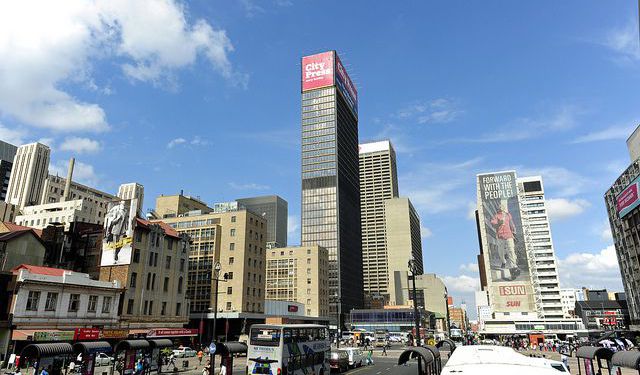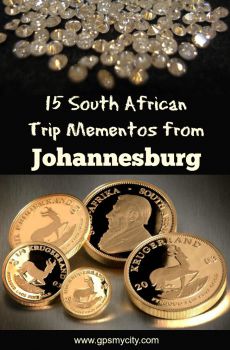
National Bank Building, Johannesburg
The National Bank Building, also known as the Corner House, was crafted by the acclaimed architects Leck and Emley in the year 1903, and the construction reached its completion in 1904. In the year 1902, Leck and Emley had previously undertaken the design of the adjacent Corner House building, which was finalized in 1904, strategically situated at the intersection of Simmonds and Commissioner Streets. The exterior of the newly constructed National Bank Building seamlessly harmonized with the Corner House, and it is believed that J.B. Taylor, who served as the chairman of the Corner House and concurrently held a directorship at the National Bank, advocated for the amalgamation of the two structures.
In 1953, the bank, now under the banner of Barclays, replicated Taylor's vision. They engaged Gordon Leith to conceive the third segment of the edifice - the Market Street extension. This extension was meticulously designed to align with the existing two structures, thus creating a unified and coherent complex.
The architectural style of the building is characterized by late Victorian Neo-Classical elements, highlighted by an alluring copper dome adorning the corner. Within the banking hall, a glass dome spans overhead, infusing the interior with abundant natural light, creating a spacious and luminous atmosphere. The remainder of the roofscape is comprised of a flat concrete slab. The interior design mirrors the meticulous approach to proportion, featuring exquisite craftsmanship in details like paneling and parquet flooring.
The National Bank Building has been officially recognized as a national monument by the PHRAG due to its historical and cultural significance.
In 1953, the bank, now under the banner of Barclays, replicated Taylor's vision. They engaged Gordon Leith to conceive the third segment of the edifice - the Market Street extension. This extension was meticulously designed to align with the existing two structures, thus creating a unified and coherent complex.
The architectural style of the building is characterized by late Victorian Neo-Classical elements, highlighted by an alluring copper dome adorning the corner. Within the banking hall, a glass dome spans overhead, infusing the interior with abundant natural light, creating a spacious and luminous atmosphere. The remainder of the roofscape is comprised of a flat concrete slab. The interior design mirrors the meticulous approach to proportion, featuring exquisite craftsmanship in details like paneling and parquet flooring.
The National Bank Building has been officially recognized as a national monument by the PHRAG due to its historical and cultural significance.
Want to visit this sight? Check out these Self-Guided Walking Tours in Johannesburg. Alternatively, you can download the mobile app "GPSmyCity: Walks in 1K+ Cities" from Apple App Store or Google Play Store. The app turns your mobile device to a personal tour guide and it works offline, so no data plan is needed when traveling abroad.
National Bank Building on Map
Sight Name: National Bank Building
Sight Location: Johannesburg, South Africa (See walking tours in Johannesburg)
Sight Type: Attraction/Landmark
Guide(s) Containing This Sight:
Sight Location: Johannesburg, South Africa (See walking tours in Johannesburg)
Sight Type: Attraction/Landmark
Guide(s) Containing This Sight:
Walking Tours in Johannesburg, South Africa
Create Your Own Walk in Johannesburg
Creating your own self-guided walk in Johannesburg is easy and fun. Choose the city attractions that you want to see and a walk route map will be created just for you. You can even set your hotel as the start point of the walk.
Historical Buildings Walking Tour
Since founded in 1886, following the discovery of gold on what used to be farmland, Johannesburg has evolved into an economic powerhouse of Africa. While most of the city's early buildings adopted architectural styles from its colonial parent, the British Empire, some of them also emulated the prowess of New York City. Let's take a closer look at some of these construction marvels.
... view more
Tour Duration: 1 Hour(s)
Travel Distance: 0.7 Km or 0.4 Miles
... view more
Tour Duration: 1 Hour(s)
Travel Distance: 0.7 Km or 0.4 Miles
Johannesburg Introduction Walking Tour
Johannesburg, or Joburg, or "City of Gold", as it is often informally called, is South Africa's largest city. The area's original inhabitants included hunter-gatherers from the San tribes and the Ndebele, a tribe associated with the Zulu. A gold rush in 1884 lead to Johannesburg's founding in 1886. Within a decade, the population had grown to 100,000 inhabitants.
Much... view more
Tour Duration: 1 Hour(s)
Travel Distance: 2.9 Km or 1.8 Miles
Much... view more
Tour Duration: 1 Hour(s)
Travel Distance: 2.9 Km or 1.8 Miles
Useful Travel Guides for Planning Your Trip
South African Sweets and Pastries
A melting pot of the Dutch, British and African traditions, the culture of South Africa embraces flavorful cuisine in which traditional desserts play an important role. South Africans love it sweet – be it a veggie dish or a barbecue sauce on meat, let alone purpose-made pastries that they are...
15 Uniquely South African Souvenirs to Bring Home from Johannesburg
One of the most fascinating cities in Africa, Johannesburg is a showroom for all things South African - a mixture of native and European trends, deeply rooted in local habits and traditions. To find your way around many of the delights Jo'burg has to offer and to pick up some as a remembrance...




